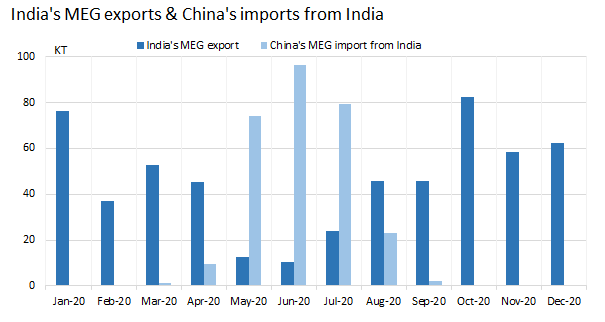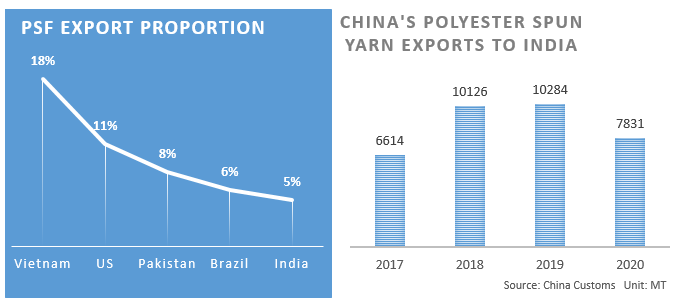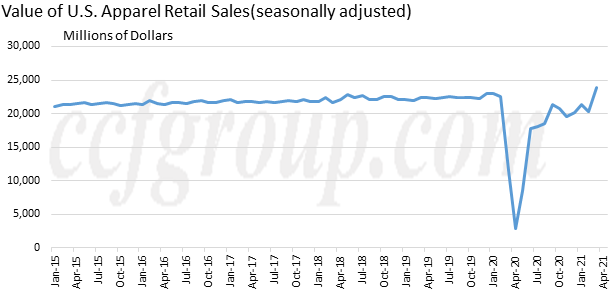Impact of India's COVID-19 crisis on China's polyester industry
Impact on polyester feedstock
Indian PTA capacity totals 10.21 million tons (100), MEG 1.9 million tons (49), polyester 8.3 million tons (1250), cotton 6 million tons (20) and cotton yarn 4 million tons (14). From the perspective of India's capacity distribution, India accounts for a greater proportion in the cotton spinning field. In the polyester field, PTA capacity is relatively influential in Asia. At the same time, polyester capacity is second only to China in Asia, and MEG relies on imports in part. (Global capacity in parentheses)
China is PTA supplier as of the overcapacity in domestic market. According to the export data, India has been the main destination of China’s PTA exports in the past few years. During January-March of 2021, nearly 200,000 tons PTA was exported to India and this part of exports will also be affected by the outbreak of epidemic in India. It is expected that the overall export volume will reduce to about 250,000 tons. Compared with domestic consumption, the impact is relatively small, but it is still an impact on the overall surplus of domestic PTA.

MEG is a kind of end-use product in China as China is a net importer of MEG. India's MEG capacity shortage is around 880kt/year, in line with India's actual annual MEG import volume. Currently India's imports are around 1 million tons per year, with 70,000-80,000 tons per month. In terms of origin, imports mostly come from Saudi Arabia as well as Kuwait which are both net exporters. So, assuming that India's domestic demand for MEG weakens, those imports will be transferred to other countries. Meanwhile, most of India's MEG exports flow to China. Therefore, when India domestic MEG demand weakens, MEG cargoes would be shipped to China. India's MEG demand due to the pandemic is estimated at more than 30,000 tons per month, or even higher.

In May-June 2020, during the two months of the Indian lockdown due to the pandemic, there was a significant increase in China's imports of MEG from India, indicating an actual logistical shift on the feedstock side.
Impact on polyester finished goods
China plays a similar role as India in terms of polyester finished goods, which are both processing factories. Exports of PFY and PSF to India accounted for around 4% of the total in China. PFY exports totaled near 3,500kt in China. That meant exports of PFY to India approached around 150kt, equivalent to around US$150 million. Therefore, India and China have low relation in terms of PFY trade.

Exports of polyester spun yarn to India were near 10kt in China, occupying below 30% of total production within China.
According to the data on end-user market, exports of textiles in India took up steady proportion in total textile export in Southeast Asia. In the past decade, India always accounted for above 15% in total textile export in Southeast Asia despite of growing exports in other nations, with the total export value around US$10 billion.
Processing capability of India has been impaired impacted by the pandemic. Under such circumstance, the value chain in China, as a processing factory too, is expected to be benefitted. The transfer pressure on feedstock side may be relatively smaller (trade of PFY and polyester spun yarn is small). The gains on finished goods will increase.
In view of the status in 2020, demand outside China rebounded after touching bottom in May-Jun after the pandemic outburst worldwide. Exports in Southeast Asia hit bottom in end-Mar. The pandemic in Southeast Asia peaked in Apr-May. India started blockade in Apr-Jun. During this period, exports in China did not grow obviously. Therefore, supply and demand was both affected in 2020.
In 2021, demand is recovering in Europe and US. Sales of apparels have returned to normal in US. However, the second wave of pandemic in India is worse than 2020. Supply gap is supposed to be filled by other processing regions in Asia amid upward demand.

Based on the import and export data on cotton textile value chain in India, supply of cotton and cotton yarn was excessive in India, namely India was a big exporter of cotton and cotton yarn. Cotton production was affected little in India, while cotton yarn export was more impacted. Therefore, cotton yarn profit increased in other cotton yarn producers (mainly China). As for cotton sector, supply did not change in China, but demand grew, which lifted cotton price.
Summary
India plays an important role in the global polyester industry chain. Assuming that its domestic industry has been affected by the pandemic to a certain extent, it will have impact on the raw materials and finished products of the polyester industry chain. China’s MEG imports may increase as cargoes originally to India may be transferred to China. It is optimistically estimated that it will be more than 30,000 tons a month. For PTA, India is currently the main export destination. Therefore, the epidemic in India will affect China’s PTA exports, but the overall impact is relatively small. In terms of finished products, China and India are both terminal textile processing links. Part of its work orders may be transferred to China to support domestic textile processing profits, which is supportive to polyester filament yarn.
- Top keywords
- Cotton Price
- Cotton Futures Price
- Cotton Futures
- CZCE
- PTA Futures Price
- Chemical Fiber
- Polyester Prices
- Wool price
- PTA Futures
- Shengze Silk
- China
- Yarn Price
- price
- China Textile City
- Fibre Price
- Benzene Price
- Cotton
- Index
- Cotton Index
- PTA
- fabric price
- NYMEX
- Top 10
- textile industry
- Spot Cotton
- Cotton Yarn
- Polyester Price
- Futures
- PTA Price
- cotton yarn price

